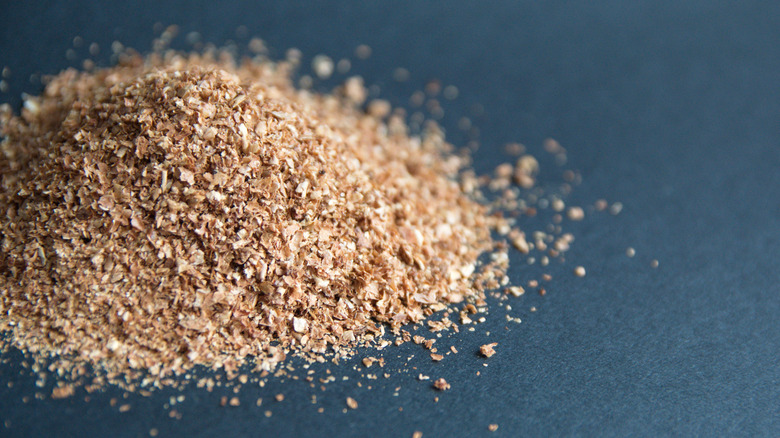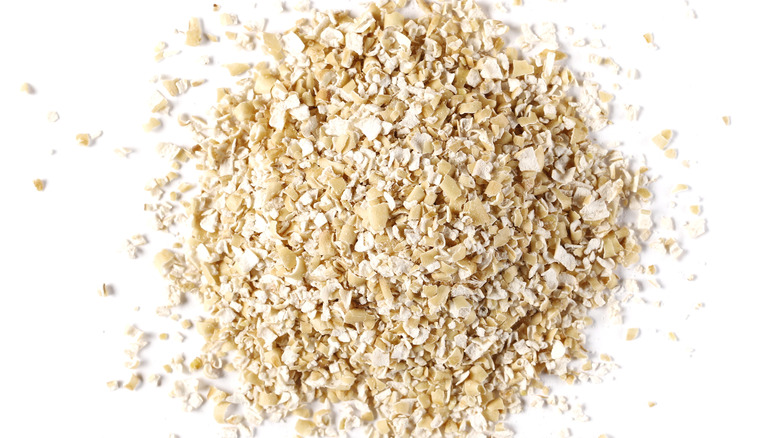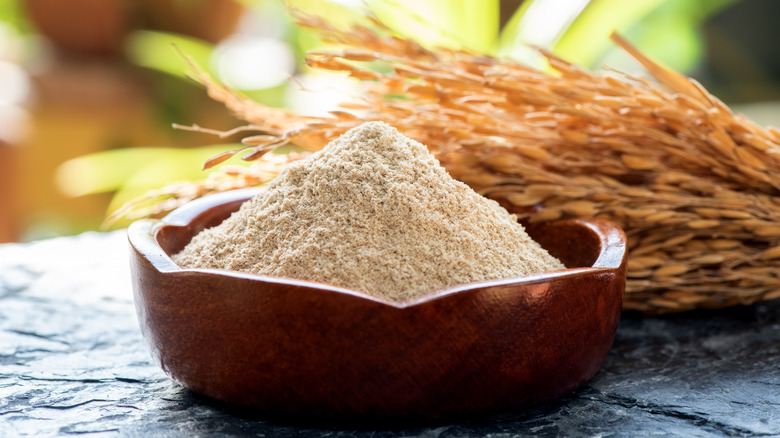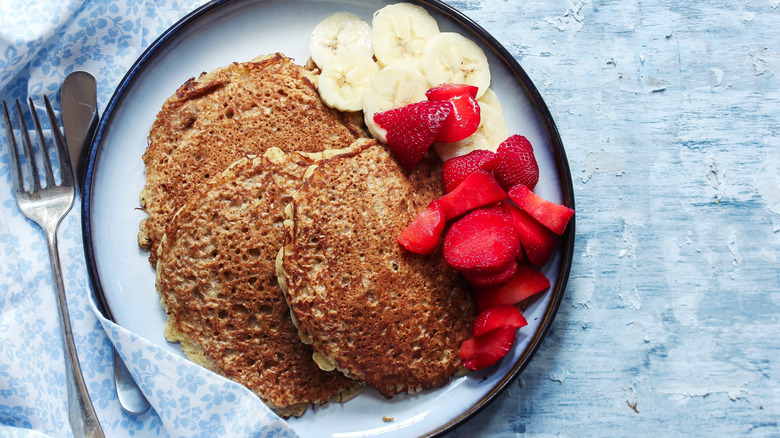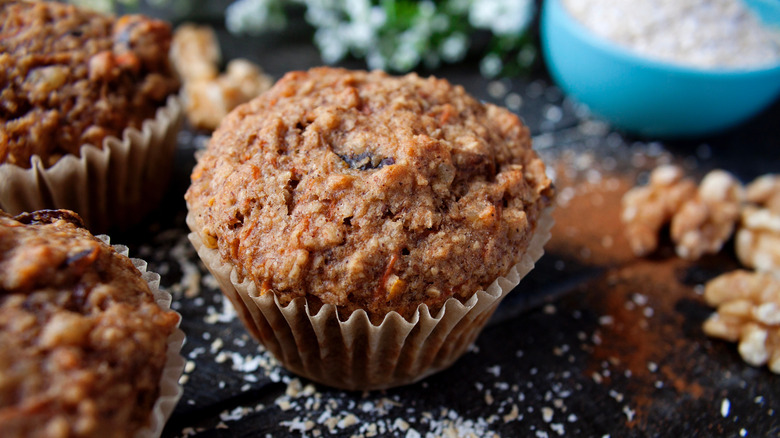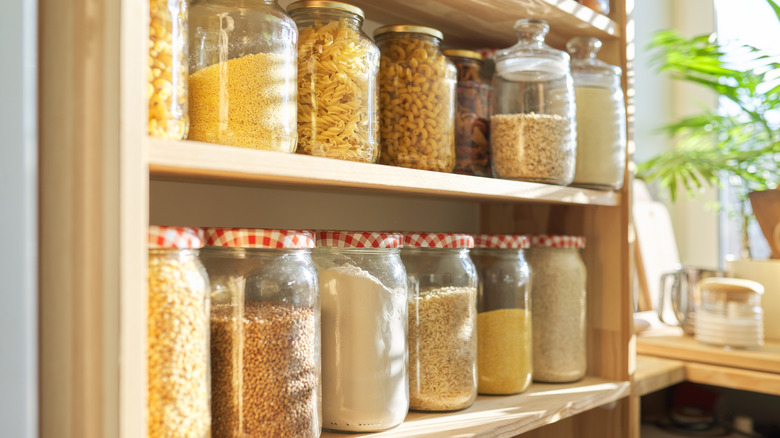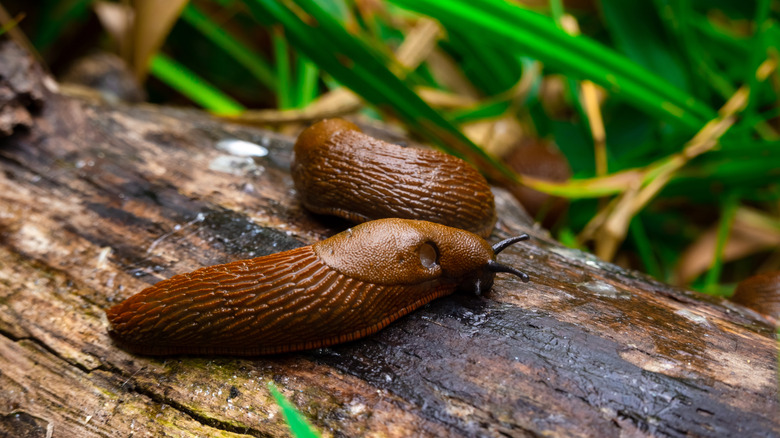What Is Bran And Is It Actually Nutritious?
When you think of bran, "Game of Thrones" may initially come to mind. In this case, however, we're not talking about the Three-Eyed Raven with supernatural powers who goes by the name of Bran Stark. Still, there's no need to be disappointed, as the bran we're referring to has some superpowers of its own that may make you want to add it into your diet.
So, what is bran? Bran is part of the holy trinity that makes up any whole grain. As explained by Dummies, a whole grain kernel consists of bran, endosperm, and germ. The bran is the hard outer layer surrounding the germ and endosperm, and it is often removed during the refining process along with the germ, leaving only the endosperm. The bran consists primarily of soluble and insoluble fiber, the good stuff that fills you up and is full of protein. It is a key part of any type of grain, but it is also present in nuts, shares Food Processing. Robert Miltner, vice president of business development for Nut-trition Inc., told the outlet, "Almond bran is created from the brown outer skin of an almond removed during the almond blanching process."
What are the different types of bran?
Bran is a part of all whole cereal grains. It is often removed during the refining process, which means it can be consumed in two different ways: within whole grains or on its own as a byproduct. If you want to consume pure bran, you have the choice of a few different types, such as bran from rice, oats, wheat, and corn, explains The Spruce Eats. Each type has different uses but is usually found ground into fine flakes and packaged in bags or boxes. Corn bran has a mild flavor that can be used to subtly add a nutritional boost to your recipes, while rice bran is harder to find but is lauded for its health benefits. Oat bran is often present in packaged oats, making the ingredient a favorite for bran muffins and cookies.
Most likely, however, you'll be consuming wheat bran, the most commonly found bran product boasting tons of health perks. By eating just ½ cup of wheat bran, you can consume 99% of the daily recommended value of dietary fiber, per Healthline. It's also said to aid in weight loss and digestion, and its pleasantly nutty flavor makes it taste good in a variety of breakfast foods and desserts.
Why is bran often removed from whole grains?
The Harvard School of Public Health explains that the industrial revolution of the 19th century fundamentally changed how we process and consume grains. New agricultural inventions made it easier to separate the bran and germ from the whole grain, leaving only the endosperm, which — in the case of wheat — is turned into the refined flour we know and love. Why refine whole grains at all? The bran and germ, while edible and nutritious, make the grain harder to chew and digest, and the refined grain has a longer shelf life. Of course, without things like refined wheat, we would not have all the yummy foods we can enjoy with white flour. On the other hand, refined grains that are stripped of their bran and germ give us fewer nutritional benefits.
Specifically, Harvard shares you are getting 90% less vitamin E and half the vitamin B when you eat refined flour instead of whole wheat. The Oldways Whole Grain Council notes when you take away the bran and the germ from a whole grain, you lose 25% of the protein. Most strikingly, you're missing out on the significant fiber that bran adds to your diet. Thankfully, it's easy to incorporate bran back into your food; Today's Dietician suggests that you "sprinkle" your favorite bran — be it oat, corn, rice, or wheat — into whatever foods and recipes you wish. That way, you can quickly add that fiber back into your food and reap the benefits.
What does bran taste like?
Wheat bran is the type of bran we most commonly consume, and its taste is often described as sweet, toasty, and nutty. Of course, since you're probably not eating bran by the spoonful, its flavor also depends on the recipes or products in which you consume it. One popular way to eat bran is in cereal, which can have mixed reviews. Some customers on Influenster compared the taste of Kellogg's All-Bran cereal to "cardboard," while others called the brand's Cracklin' Oat Bran cereal their favorite (via Influenster).
Not one to buy packaged cereals? Other popular ways to consume bran are in homemade goods like pancakes, muffins, and cookies, in which its flavor can be complemented by nuts, dried fruit, sweeteners, and more. Healthline suggests adding it into smoothies or on top of yogurt, which would be great for anyone who likes the combination of fruit and nutty flavors — can you say adult PB&J?
Nutritional information about bran
Bran, no matter the type, is full of nutritional elements that can help regulate the body. Most importantly, bran is a key source of insoluble fiber, which refers to fiber that does not dissolve in water, per Healthline. Insoluble fiber helps regulate your bowel health and movements and may help prevent diabetes. Fiber also assists the body in balancing cholesterol, controlling blood sugar, and telling your brain that you're full.
Wheat bran, specifically, boasts a dense nutritional profile — especially considering its relatively low caloric impact of 63 calories per ½ cup, explains another Healthline article. This amount contains 5 grams of protein and significant portions of the daily recommended value of minerals including zinc, copper, manganese, and selenium. However, some may want to remember that wheat bran is not gluten-free, and it may cause discomfort for those who have IBS. A final word to the wise: Incorporate bran into your diet gradually, and drink lots of liquids when doing so, in order to help with digestion.
How to buy and store bran
You can buy different types of bran at many grocery stores, both packaged and in bulk form, and even online from retailers including Amazon. In supermarkets, look for it in the bulk section or in the cereal or baking aisles. You may have an easier time finding wheat and oat bran, the more common types, in supermarkets. Rice bran, on the other hand, is not as widely available (via The Spruce Eats), so you may have to visit a specialty store to find it.
As far as storing your bran, LEAFtv says that you want to keep it in an airtight container away from heat and light. The site notes that because you will likely go through your bran slowly, it is best to store it in the refrigerator or freezer to prevent it from either going rancid or, perhaps worse, attracting pantry moths. If stored properly, it should last for about a year, but you may still want to buy it from the bulk section in very small amounts to ensure freshness.
How to use bran for gardening
Bran also has a practical use outside of your dietary needs: It is allegedly great for getting rid of those slugs in your garden that keep snacking on your plants, flowers, vegetables, and fruits. According to Gardeners' World, making bran traps for slugs is a thing. What is a bran trap? It's kind of simple. Simply pour bran flakes over the plants and soil bed where you have slug problems, and the slugs will feast on the bran.
Remember, bran requires a lot of liquid to help it move through your system, so the idea behind the trap is that the slugs will become "bloated and dehyrdated," making them vulnerable to predators such as birds. Does this method actually work? Per the Daily Mail, there isn't sufficient evidence to prove that it does indeed get rid of those slimy and pesky pests; however, there are plenty of individuals who swear by this organic method.
